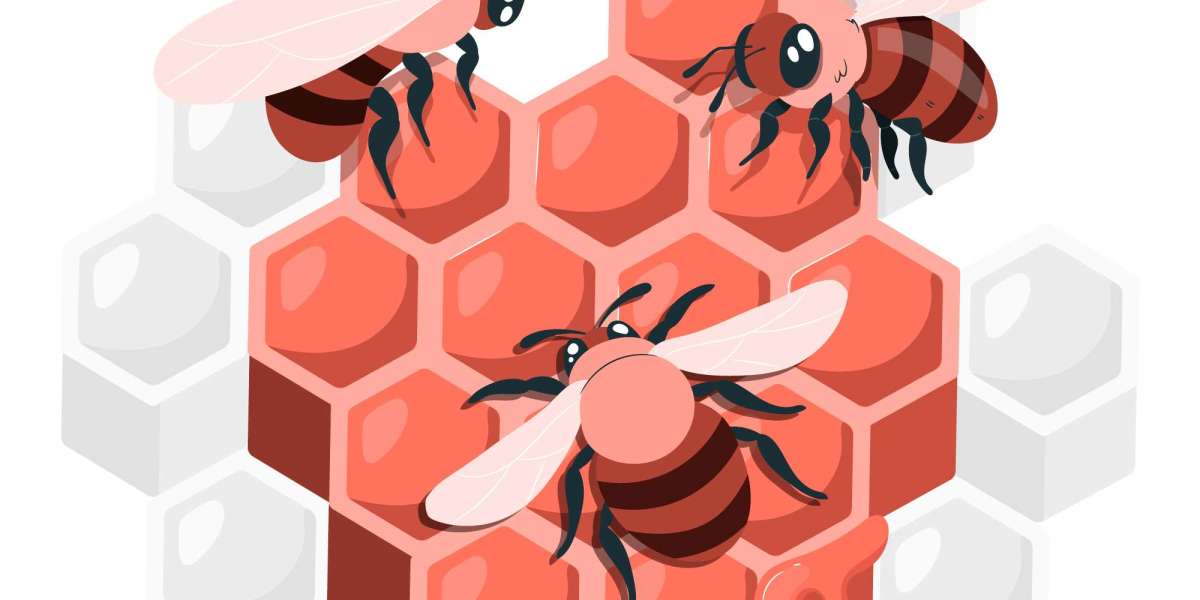Beekeeping has taken a technological leap with the advent of IoT Beehive Monitoring Systems, making the practice more efficient and sustainable. As beekeepers embrace modern methods, they also face age-old problems like ant invasions. Moreover, the role of honey bees in our ecosystem continues to grow more crucial, making their conservation a priority. In this blog, we’ll dive into how IoT is transforming beekeeping, share effective tips to keep ants out of beehives, and highlight the greater impact of honey bees and their evident future.
In recent years, the beekeeping industry has experienced a transformative shift driven by technology, environmental consciousness, and sustainable farming practices. Beekeepers, both commercial and hobbyist, are increasingly adopting IoT Beehive Monitoring Systems to improve efficiency and hive health. Alongside modern advancements, traditional challenges like pest control, particularly ants, remain critical. Moreover, understanding the greater impact of honey bees and their evident future is essential for environmental sustainability.
1. The Rise of IoT in Modern Beekeeping
What Is an IoT Beehive Monitoring System?
An IoT Beehive Monitoring System is a smart solution equipped with sensors and wireless communication tools that allow real-time monitoring of a beehive’s internal environment. These systems track various parameters such as:
- Temperature and humidity
- Hive weight (honey production)
- Sound frequency (to detect queen presence or swarming)
- Bee activity and movement
- External weather conditions
Data is transmitted to a central hub or cloud platform, allowing beekeepers to make informed decisions without disturbing the hive.
Components of a Smart Hive System:
- Sensors: For temperature, humidity, vibration, audio, CO₂, etc.
- Microcontroller/Transmitter: Connects to the internet or cellular network.
- Mobile or Web App Interface: Provides insights, graphs, and alerts.
Benefits of IoT in Beekeeping
- Remote Monitoring: Monitor hives from your smartphone or computer.
- Predictive Maintenance: Detects issues like hive overheating, swarming, or reduced bee activity.
- Improved Hive Health: Keep optimal conditions for bee productivity and survival.
- Data-Driven Insights: Track seasonal patterns and improve hive management.
By integrating IoT, beekeepers can reduce manual inspections, minimize hive disruptions, and ensure the wellbeing of their colonies.
2. Effective Tips to Keep Ants Out of the Beehive
Ants are a persistent nuisance in apiaries. They are attracted to the sweet scent of honey and may invade hives, robbing them of resources and causing stress to the bees.
Here are effective tips to keep ants out of your beehive:
A. Use Ant-Proof Hive Stands
- Elevate your hive using stands with moat-style legs filled with water or oil to block ant access.
- Ensure that nothing bridges the moat, such as tall grass or debris.
B. Apply Sticky Barriers
- Wrap the hive stand legs with sticky tape or petroleum jelly to create a physical barrier.
- Reapply as needed, especially after rain.
C. Maintain Clean Surroundings
- Avoid spills of sugar water, honey, or pollen substitutes around the hive.
- Regularly clean the area to prevent attracting ants.
D. Use Natural Ant Repellents
- Sprinkle cinnamon, diatomaceous earth, or coffee grounds around the base of the hive.
- These substances act as natural deterrents without harming the bees.
E. Relocate Ant Colonies
- Trace ant trails back to their nest and use boiling water or natural deterrents to eliminate the source.
- Avoid chemical pesticides as they may harm the bees or contaminate the hive.
Combining these methods can drastically reduce ant infestations and protect your hive.
3. The Greater Impact of Honey Bees and Their Evident Future
Why Honey Bees Matter
Honey bees are essential pollinators responsible for fertilizing over 75% of the world’s flowering plants and more than a third of our food crops. Their work supports:
- Agricultural productivity (fruits, vegetables, nuts)
- Biodiversity by maintaining natural plant communities
- Livelihoods through honey, beeswax, and pollination services
Without honey bees, the global food system would face severe disruptions.
Challenges Facing Honey Bees
Despite their importance, bee populations are declining due to:
- Pesticide exposure
- Habitat loss
- Climate change
- Diseases and parasites (like Varroa mites)
- Colony Collapse Disorder (CCD)
These threats emphasize the urgent need for proactive beekeeping strategies and global awareness.
The Evident Future of Honey Bees
The future of honey bees depends on a blend of traditional practices and modern technology. Here’s what lies ahead:
- Wider Adoption of IoT Monitoring Systems to detect problems early and reduce mortality.
- Urban Beekeeping to increase local biodiversity and pollination.
- Climate-Resilient Bees through selective breeding and genetic research.
- Educational Campaigns to raise awareness about bee conservation.
- Government Policies promoting sustainable agriculture and pollinator protection.
With the right approach, we can ensure a thriving future for honey bees and, in turn, for ourselves.
4. Merging Innovation with Responsibility
The beekeeping industry is evolving rapidly. While IoT Beehive Monitoring Systems offer convenience and precision, they should be complemented with responsible beekeeping practices.
By tackling challenges like ant invasions and environmental threats, beekeepers can build a sustainable and productive future. Moreover, spreading awareness about the vital role of honey bees can inspire more individuals to support conservation efforts.
The Role of IoT in Bee Conservation
Beyond farm management, IoT technologies support global bee conservation efforts:
- Enable research by collecting large-scale hive data.
- Improve early disease detection and reduce colony collapse.
- Support citizen science hobbyist beekeepers can contribute to global databases.
Empowering Small-Scale Beekeepers
IoT tools are increasingly affordable and open-source. Beekeepers with just a few hives can:
- Monitor remotely while working full-time jobs.
- Get alerts for hive theft or environmental stress.
- Make data-driven decisions about relocation or treatment.
5. The Importance of IoT in Modern Beekeeping
The global environment is evolving faster than ever before. From shifting weather patterns to invasive pests and widespread pesticide use, bees are increasingly under threat. Beekeepers must therefore shift from reactive to proactive beekeeping and this is where IoT becomes indispensable.
Why Traditional Monitoring Isn’t Enough
Manual inspections, while valuable, come with several downsides:
- They disturb bees and stress the colony.
- Inspections may miss subtle issues developing between visits.
- Weather, time constraints, or remote locations can hinder inspections.
IoT monitoring systems address these issues by providing continuous, real-time data, enabling faster and more accurate responses to problems.
Preventing Colony Collapse with IoT
One of the most significant threats to bees is Colony Collapse Disorder (CCD), where bees suddenly abandon the hive. By detecting early signs such as unusual temperature drops, changes in vibration, or bee inactivity, IoT systems give beekeepers critical lead time to intervene.
6. Top Benefits of IoT Beehive Monitoring Systems
Let’s explore the comprehensive benefits of integrating smart beekeeping tools:
Real-Time Alerts
Get instant notifications about:
- Hive temperature/humidity spikes or drops
- Sudden weight loss (indicating honey theft, swarming, or disease)
- Acoustic patterns signaling queenlessness or distress
Remote Accessibility
You can monitor hives from your smartphone or laptop anywhere in the world ideal for:
- Beekeepers managing multiple hives across locations
- Farmers integrating pollination services
- Researchers observing hives in wild or remote ecosystems
Data-Driven Decision Making
With months of data at your fingertips, you can:
- Identify optimal times for harvesting
- Detect seasonal behavior patterns
- Compare hive health across colonies
This leads to smarter resource allocation and higher yields.
Reduced Hive Intrusions
Unnecessary inspections can cause:
- Bee aggression
- Queen disturbance
- Loss of brood temperature control
IoT devices allow you to inspect only when needed, promoting hive stability.
Enhanced Hive Security
Some advanced IoT systems include GPS and motion sensors to detect theft or animal attacks. This is particularly helpful in rural and commercial apiaries.
Sustainability and Eco-Consciousness
IoT encourages sustainable beekeeping by:
- Reducing chemical usage (you treat only when necessary)
- Supporting conservation-based decisions
- Enabling low-impact monitoring
7. Industry Growth: The Rise of Smart Beekeeping
As environmental and agricultural pressures mount, the beekeeping industry is evolving. Smart technologies are leading this transformation.
Market Growth Insights
According to recent reports:
- The global smart beekeeping market is expected to grow at a CAGR of over 10% between 2024 and 2030.
- Demand is highest in regions like North America, Europe, and parts of Asia, driven by agricultural modernization.
- The adoption of AI and machine learning in beekeeping is further expanding the scope of data analysis and prediction.
Innovations on the Horizon
The future promises even more enhancements:
- AI Predictive Algorithms: Forecast swarming, disease outbreaks, and seasonal behaviors
- Blockchain for Honey Traceability: Transparency in honey sourcing and authenticity
- Solar-Powered IoT Devices: Off-grid monitoring even in remote forests or hills
- Drones for Hive Inspection: Aerial views of remote hives without physical travel
Conclusion
Smart beekeeping is more than just a trend, it's a necessity. By adopting IoT Beehive Monitoring Systems, practicing effective ant prevention techniques, and acknowledging the greater impact of honey bees, we pave the way for a resilient ecosystem and secure food supply. The future of beekeeping is smarter, safer, and more sustainable. With the adoption of IoT Beehive Monitoring Systems, the implementation of effective tips to keep ants out of the beehive, and a collective recognition of the greater impact of honey bees, we can ensure that our buzzing friends thrive for generations to come. The intersection of nature and technology is redefining how we care for our most essential pollinators. Whether you're a seasoned beekeeper or a curious beginner, adopting an IoT Beehive Monitoring System can drastically improve your hive management while contributing to global bee conservation.
At the same time, tackling age-old challenges like ant infestations ensures that your hive environment remains stable and safe. With actionable pest control methods and real-time hive tracking, you create a thriving ecosystem for your bees.
And when we zoom out, it’s clear: The health of honey bees reflects the health of our planet. With IoT systems, we not only become better stewards of our hives but also of the Earth itself.



